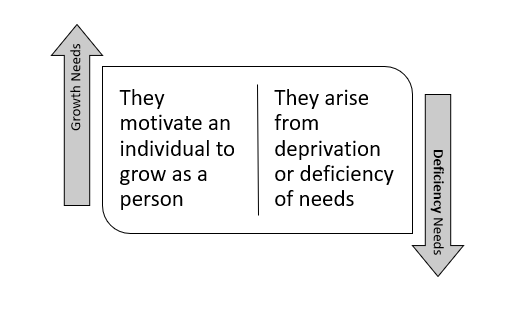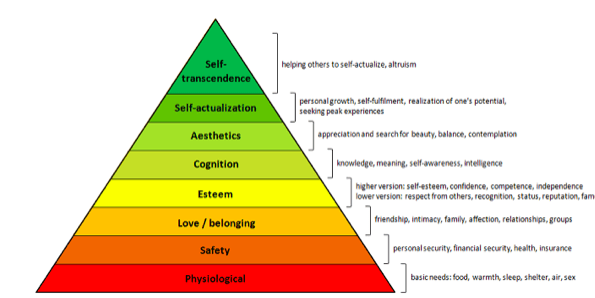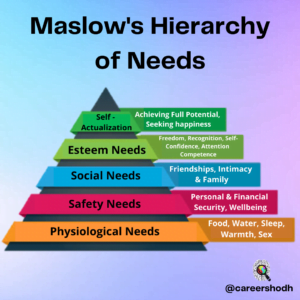Abraham Maslow is well known for Maslow’s Need Hierarchy Theory of Motivation. The theory includes basic 5 levels of needs. Non-fulfillment of these needs motivates a being to take action and fulfill them. Thus, any human works in order to satisfy these needs. Therefore, this is an important aspect of Motivation. Moreover, Maslow’s Need Hierarchy Theory of Motivation is a part of the humanistic approach to study motivation. Let’s get familiar with all these terms first.
What is Motivation?
Motivation is a key psychological concept that explains why individuals engage in certain behaviors. It is described as a hypothetical process because it cannot be directly observed or measured. Instead, motivation is inferred based on changes in behavior in response to specific stimuli. For example, if a person suddenly shifts from inactivity to action (like getting food after feeling hungry), we infer that motivation is at play.
The definition provided by Petri (1996) captures the dynamic nature of motivation—it starts, directs, and sustains activities to satisfy needs or desires, both physical (such as hunger) and psychological (such as a need for achievement or social connection). The term itself originates from the Latin word movere, which means “to move,” emphasizing that motivation is the driving force behind our actions. It energizes and propels us to fulfill certain needs or objectives, much like how hunger propels someone to get food.
In essence, motivation explains the internal process that guides behavior toward goal fulfillment, whether that goal is basic survival or a more complex psychological desire.
Humanistic Approach to Motivation
The humanistic approach to motivation emphasizes the role of personal growth, self-actualization, and fulfillment as key driving forces behind human behavior. Rooted in the belief that humans are inherently good and driven by an innate desire to reach their fullest potential, this approach contrasts with other motivational theories that focus on biological needs or external rewards.
Key Features of the Humanistic Approach to Motivation
- Focus on Cognitive and Emotional Factors: Humanistic theories argue that people are motivated by more than just basic biological drives or extrinsic rewards. They seek meaning, purpose, and personal fulfillment. This approach emphasizes the importance of thoughts, feelings, and self-concept in shaping motivation. Individuals are driven not just by external stimuli but also by their desire to grow, achieve, and live authentically.
- Self-Actualization as the Ultimate Goal: One of the central concepts of humanistic motivation is the idea of self-actualization, or the process of realizing one’s full potential. This was a key focus for Abraham Maslow, whose Hierarchy of Needs places self-actualization at the top. People are motivated by a desire to grow, improve, and ultimately become the best versions of themselves. This higher-order motivation is what separates the humanistic approach from other theories that emphasize survival or basic needs.
- Innate Drive for Growth and Development: Humanistic theorists, including Carl Rogers and Maslow, believed that humans have an innate drive to become their best selves. This drive is natural and intrinsic, meaning that motivation comes from within the person rather than being imposed by external forces. People are seen as proactive in seeking experiences and opportunities that will help them grow emotionally, psychologically, and intellectually.
- Personal Responsibility and Free Will: The humanistic approach highlights the role of free will and personal responsibility in motivation. Individuals are believed to have control over their actions and decisions, and they are responsible for shaping their lives in meaningful ways. This perspective empowers people to take charge of their personal development and well-being, reinforcing the idea that they are active agents in their own growth.
- Holistic View of Human Behavior: Humanistic motivation theories take a holistic view of the individual, considering all aspects of the person, including their emotional, cognitive, and physical needs. This approach sees motivation as more complex and multi-dimensional than a simple response to stimuli or rewards. It considers how people’s unique life experiences, personal values, and aspirations influence their actions.
- Positive Human Potential: The humanistic approach is inherently optimistic about human nature. It suggests that, given the right conditions, individuals will naturally strive toward positive outcomes, such as love, creativity, and personal growth. This perspective contrasts with theories that emphasize pathology or negative drives (e.g., Freud’s psychoanalytic theory, which focuses on unconscious conflicts).
What is a Hierarchy?
A hierarchy is a system of organizing entities into different ranks or levels of importance.
‘The hierarchy of needs’ refers to the concept of sequence of particular needs given by Abraham Maslow.
Maslow’s Need Hierarchy Theory of Motivation
Abraham Maslow developed the theory of hierarchy of needs. It suggests that individual needs exist in a hierarchy consisting of –
- Physiological needs
- Security needs
- Belongingness needs
- Esteem needs
- Self-actualization needs.
Eventually, Maslow structured these needs into a pyramid form, thus, building a hierarchy. The hierarchy flows from bottom to top.
1. Physiological Needs
These include the most basic needs that are vital to survival. Such as the need for water, air, food and sleep. Maslow believed that these needs are the most basic and instinctive needs in the hierarchy. In fact, all needs become secondary until an individual meets these physiological needs.
- Homeostasis
- Food
- Water
- Sleep
- Warmth
- Sex
Until and unless a person satisfies these needs, his / her body cannot function optimally. Moreover, a person cannot fully move on to the next level of needs without fulfilling the primary needs. For example, an individual may find it difficult to focus on his job / studies due to inadequate sleep.
2. Security Needs
These include needs for safety and security. Security needs are important for survival, but they are not as demanding as the physiological needs.
- Steady employment
- Financial security
- Emotional security
- Overall wellbeing
- Health insurance
- Safe neighborhoods
- Shelter from the environment.
Neglect of these needs cause post-traumatic stress.
3. Social/ Belonging Needs
These include needs for belonging, love and affection. Maslow considered these needs to be less basic than physiological and security needs.
- Friendships
- Romantic attachments
- Families
- Companionship
- Acceptance
- Community
People deprived of these needs often suffer from anxiety and depression. In addition, lack of affection and belongingness may lead to increased violence and crime.
4. Esteem Needs
After the first three needs have been satisfied, esteem needs becomes increasingly important. Esteem needs signify our place in the community. Hence, a person must fulfill these needs to feel confident and competent.
- Personal worth
- Social recognition
- Sense of accomplishment
- Freedom & Independence
- Attention
- Competence
- Self – Confidence
Lack of self esteem may cause anxiety and depression. It induces insecurities and self sabotage.
5. Self-Actualising Needs
Self – actualization refers to the need of achieving one’s full potential. This is the highest level of Maslow’s Need Hierarchy Theory of Motivation Therefore, it is believed that once a person has completely entered the spectrum of self – actualization, the other needs do not have much value.
- Self-aware
- Concerned with personal growth
- Less concerned with the opinions of others
- Interested fulfilling their potential
- Parenting
- Pursuing a goal
- Utilizing talents and abilities
- Seeking happiness
Maslow recognized that an employee’s behavior is motivated simultaneously by several need levels. However, behavior is motivated mostly by the lowest unsatisfied need at the time. Thus, as the person satisfies a lower-level need, the next higher need in the hierarchy becomes the primary motivator. Therefore, this concept is known as the satisfaction-progression process.
Even if a person is unable to satisfy a higher need, he or she will be motivated by it until it is eventually satisfied. Physiological needs are initially the most important, and people are motivated to satisfy them first. Further, as they become gratified, safety needs emerge as the strongest motivator. Consequently, as safety needs are satisfied, belongingness needs become most important, and so forth.
However, the exception to the satisfaction-progression process is self-actualization. As people experience self-actualization, they desire more rather than less of this need.
Deficit vs. Growth Needs

Growth and Deficiency Needs
Deficit or Deficiency needs
They arise from deprivation or neglect of needs. These deficit needs, when unmet, motivate people to fulfill them. Thus, the intensity of this motivation to fulfill the need is directly proportional to the duration that need is denied.
For example, the longer a person is hungry, stronger will be his/her desire to eat.
Physiological, Security, Love & Belongingness and Esteem needs are deficit needs.
Growth Needs
They are not rooted in deprivation or lack of something. In fact, it is something that motivates an individual to grow as a person.
Self – actualization is a growth need.
Revisions in the Hierarchy (8 stage model)
Maslow kept updating and revising his theory. In addition, he updated the model of hierarchy, too. The eight-stage model includes all the five needs from the primary five stage model and the newly included – Cognitive, Aesthetic and Transcendence needs.

8 Levels of Needs
Criticism of Maslow’s Need Hierarchy Theory of Motivation
Maslow’s theory has had a powerful influence on the field of management (Heil et al., 1998) In spite of this influence, Maslow’s theory is not without its critics. There are several problems that others have highlighted. The most
serious is that there is little scientific support (Drenth et al., 1984). Like Sigmund Freud, Maslow developed his theory based on his personal observations of people. However, it would have been more evident if it was empirically gathered observations or research.
Although many people report that while they were starving, they could think of nothing but food, there is anecdotal evidence in the lives of many people, some of them quite well known, that the lower needs do not have to be satisfied before moving on to a higher need (Drenth et al., 1984).
For example, artists and scientists throughout history have been known to deny their own physical needs while
producing great works (a self-actualization need). In addition, Maslow’s work was also based on his studies of Americans. Cross-cultural research suggests that the order of needs on the hierarchy does not always hold true for other cultures.
Maslow’s needs hierarchy is one of the best-known organizational behavior theories. However, the model is much too rigid to explain the dynamic and unstable characteristics of employee needs. In fact, researchers have found that individual needs do not cluster neatly around the five categories described in the model. Moreover, gratification of one need level does not necessarily led to increased motivation to satisfy the next higher need level.
To check your understanding of the topic, take this short test – MCQ test on Maslow’s Hierarchy of Needs
References
Ciccarelli, S. K.; White J. N. Adapted by Girishwar Misra (2018). Psychology (5th Edition). Pearson.
Niwlikar, B. A. (2022, February 24). Maslow’s 5 Need Hierarchy Theory of Motivation- Most Popular Theory of Motivation. Careershodh. https://www.careershodh.com/maslows-need-hierarchy-theory-of-motivation/

